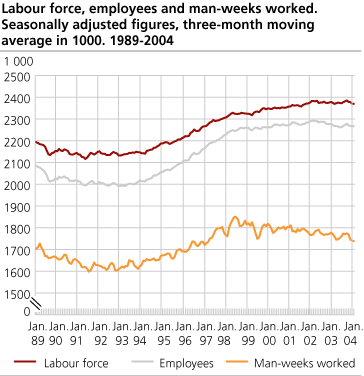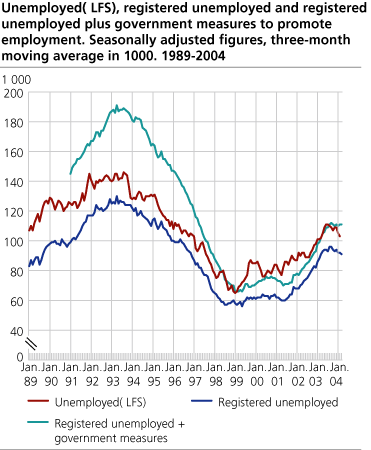Content
Published:
This is an archived release.
Employment down in manufacturing
Even though the total level of employment remained unchanged, the manufacturing figures for Q1 2004 fell by 18 000 from the year before. This is according to new figures from the Labour Force Survey.
|
Seasonally adjusted figures: Unemployment down
Unemployment went down by 6 000 from Q4 2003 to Q1 2004, while employment remained unchanged, according to seasonally adjusted figures from the LFS. The seasonal adjustment method is a favourable method of revealing the current development in the labour market, and serves as an alternative to comparisons with the corresponding quarter in the previous year. Seasonally adjusted figures are presented in a separate article. |
In addition to manufacturing, employment also declined in business activities. On the other hand, education and domestic trade showed an increase.
The number of male part-time employees went up by 10 000, while the male full-time figure declined by 14 000 from Q1 last year. Female full- and part-time employment did not show any change from last year.
9.2 per cent temporary employment
191 000 people were in temporary employment in Q1 2004, approximately the same level as in the same quarter of 2003. Temporary employment was most common in education, hotels and restaurants, in addition to health and social work. At the opposite end we find transport and communication, manufacturing, and construction.
Labour force participation down
Total labour force participation went down from 72.6 to 71.9 per cent from Q1 2003 to Q1 2004. The decline was the same for men and women, and the age groups 16-19 and 55-59 years were most strongly affected by the decline. Not since 1997 has total labour force participation been lower in Q1.
Small changes in unemployment
The number of unemployed people in Q1 2004 was 107 000, approximately unchanged from Q1 2003. The unemployed constituted 4.5 per cent of the working force, compared with 4.4 per cent one year earlier. Unemployment was highest among men - at 5.1 per cent compared to 3.8 per cent for women. A slight increase occurred from Q1 2003 for men aged 25-54, while the opposite was the case regarding women aged 16-24.
The proportion of long-term unemployed has increased from 17 to 21 per cent over the past year. Long-term unemployment is defined as having been out of work for six consecutive months and being out of work at the time of interview. The average period of unemployment increased from 17.3 weeks in Q1 2003 to 18.0 weeks in Q1 2004.
Unemployment up in Sweden
The seasonally adjusted unemployment rate for Norway was 4.3 per cent in February 2004, compared with 4.6 per cent in November 2003. EU unemployment remained flat at 8.0 per cent, while the unemployment rate in OECD countries fell from 7.0 to 6.9 per cent. The USA saw unemployment fall by 0.3 percentage points to 5.6 per cent from November to February, while Sweden experienced unemployment growth from 6.0 to 6.4 per cent. In Finland unemployment remained unchanged at 8.9 per cent. This was more or less the case also in Germany and France, according to figures from the OECD and Eurostat .
More under-employment
The number of under-employed, i.e. part-time employees seeking more work, went up from 82 000 to 97 000 people from Q1 2003 to Q1 2004. This represents 15.6 per cent of all part-time employees, compared to 13.4 per cent in Q1 2003. Men were especially affected by the increase. More than half of the under-employed were seeking full-time work.
The work hours of the unemployed and under-employed in Q1 2004 amounted to 124 000 man-weeks (full-time work), an increase of 8 000 from the corresponding quarter in 2003.
Tables:
- Table 1. Population aged 16-74 in the labour force, man-weeks worked, registered unemployed persons and persons employed by government measures. 1000 and per cent
- Table 2. Population aged 16-74 år in the labour force, employed persons and unemployed persons by sex (LFS). 1000 and per cent
- Tabell 3. Persons in the labour force and employed persons by age and sex (LFS). 1 000 and per cent
- Table 4. Population aged 16-74, employed persons by settled/usual working hours per week(1) and unemployed persons by age and sex (LFS). 1000
- Table 5. Persons in the labour force by age and sex. 1000 and as per cent of all in each group
- Tabell 6. Employed persons by sex and settled/usual working hours pr week (LFS). 1 000
- Tabell 7. Population aged 16-74 by main activity, part-time employment and age (LFS). 1 000
- Table 8. Employed persons by major industry division. 1000
- Tabell 9. Number of man-hours worked per week by industry division (LFS). 1 000
- Tabell 10. Employed persons,total, and employed persons at work by status and sex. Number of man-weeks worked and actual working hours per week (LFS)
- Table 11. Employed persons and absence from work during the whole survey week by reason for absence and sex(1). 1000 and per cent
- Table 12. Employees with temporary jobs, by major industry division (LFS). 1000 and as per cent of all employees
- Table 13. Unemployed persons by sex and age (LFS). 1000 and per cent
- Table 14. Unemployed persons by duration of job search (LFS). 1000 and per cent
- Tabell 15. Unemployed persons by main activity (LFS). 1 000
- Table 16. Unemployed and underemployed persons, by sex and desired working hours per week. Number of man-weeks (of 37,5 hours) supplied (LFS). 1000
- Table 17. Employment and unemployment for persons aged 16-74 years, seasonally adjusted, three-months moving average. Absolute figures in 1000 and unemployed persons in per cent of the labour force.
- Tabell 18. Persons in the labour force by sex and region(LFS). 1 000 and in per cent of total
- Tabell 19. Employed persons by sex and region (LFS).1 000
- Tabell 20. Employed persons by sex and regions (LFS) as per cent of all inn each group
- Table 21 Employed persons, by some major industry division and region (LFS). 1997-2003. 1 000
Contact
-
Arbeidsmarked og lønn
E-mail: arbeidsmarked@ssb.no
-
Erik Herstad Horgen
E-mail: erik.horgen@ssb.no
tel.: (+47) 93 08 68 62
-
Håvard Hungnes Lien
E-mail: havard.lien@ssb.no
tel.: (+47) 40 90 26 06


